Powertrain systems primarily relay on transmission concepts before, such as manual, automatic, and dual-clutch trasmissioni for 2WD and 4WD vehicles. Tuttavia, with the transition to fully electrified propulsion systems, the modern one has undergone a fundamental transformation. In addition electric drives and high-voltage components have become central to these systems.
Supporting development and system integration, Usually customers require cutting-edge test systems, which are capable of evaluating and optimizing both the mechanical, high-voltage electrical subsystems. Our state-of-the-art propulsion test systems design to validate a wide range of configurations, compresi diversi tipi 2WD e 4WD sistemi, speeds, coppia, Classi di potenza, nonché requisiti ad alta tensione e corrente specifici per i sistemi elettrificati.
Furthermore it also incorporates steering capabilities, enabling comprehensive vehicle-in-the-loop (VIL) Test. This approach creates a highly realistic testing environment,which essential for validating the functionality of advanced driver assistance systems (Adas) and automated driving (AD) technologies in real-world vehicle applications.
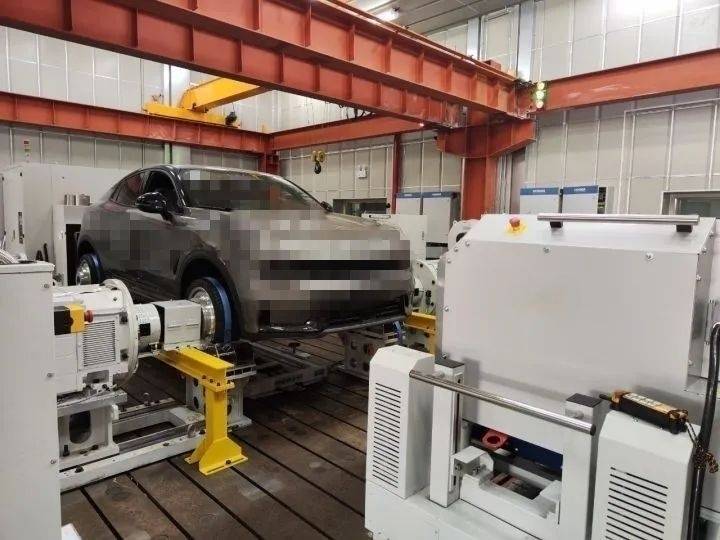
Mobilel/Portable axle-mounted dynamometers have become essential tools, which is in the automotive industry for assessing powertrain performance, moreover they provide the flexibility and precision in modern vehicle testing. These dynamometers enable engineers to measure energia E coppia in various locations, whether in workshops or within environmental chambers, providing valuable data throughout different stages of vehicle development. Therefore the adaptability ensures that manufacturers can optimize performance, verify the vehicles meet the necessary regulatory standards.
When launch in environmental chambers, portable axle-mounted dynamometers greatly enhance the ability, in order to test vehicle performance under controlled conditions. Environmental chambers can simulate a wide range of climatic scenarios, including extreme one (from -45°C to 65°C) and varying levels of humidity, all of which can significantly impact a powertrain’s efficienza E emissions. By integrating dynamometers into these chambers, manufacturers and researchers can conduct performance tests, that offer valuable insights into how different environmental factors influence vehicle operation. With controlled testing is crucial for ensuring vehicles can meet emissions, E performance standards in diverse and challenging conditions, ultimately helping to ensure their reliability and compliance across various markets.
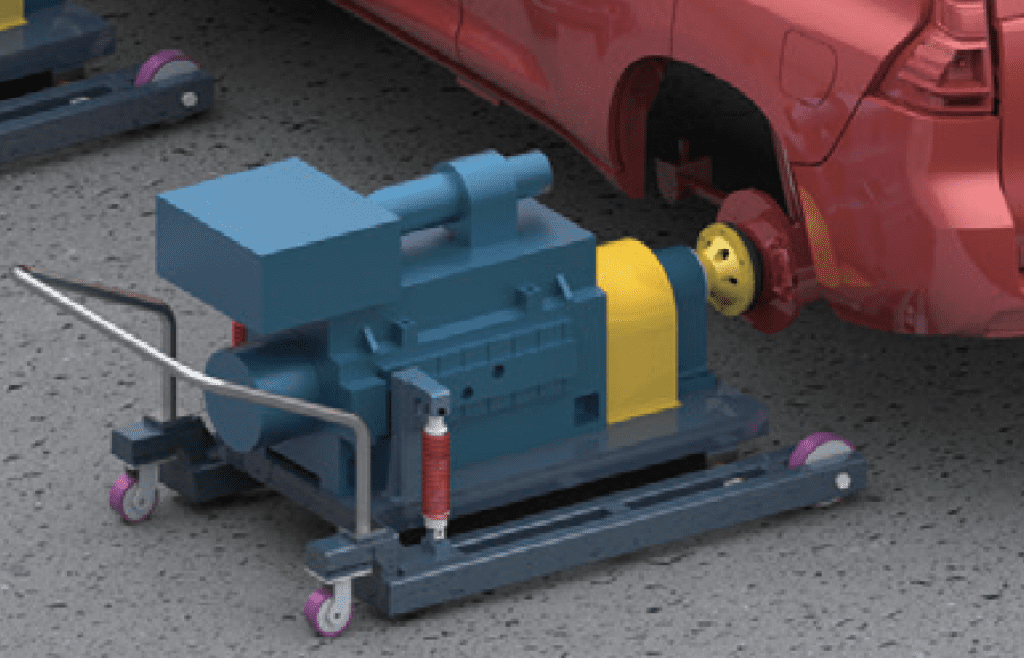
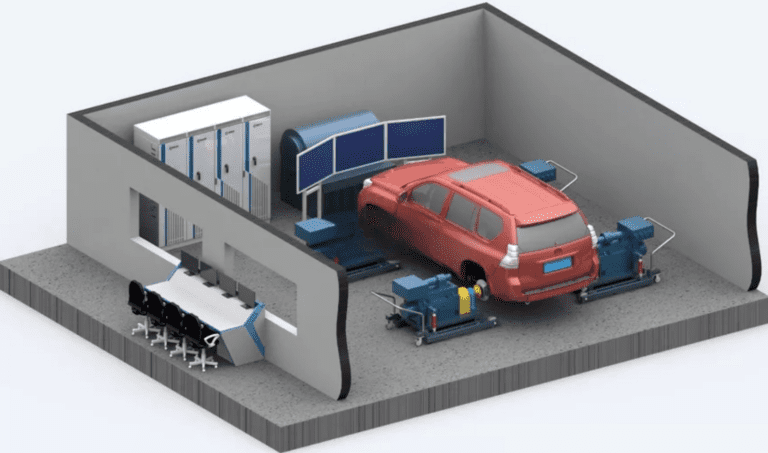
Powertrain/Hub-coupled powertrain Test Bench compose several key components, each design to ensure accurate and efficient testing of vehicle propulsori. These components include:
Mobile Low-Inertia Electric Dynamometer: The dynamometer provides precise speed and torque control, simulating real-world road load conditions. It is capable of rapid response to dynamic changes, making it ideal for simulating varying road conditions. I metodi di simulazione del carico includono:
Constant torque control
Calculated road spectrum simulation
Actual road spectrum import
User-defined load spectrum
Dynamometer Driver: This part controls dynamometer’s operation, allowing it to simulate different load scenarios and accurately replicate road conditions.
Battery Simulator: Use to simulate the electric vehicle’s battery, in addition the simulator can replace the actual battery, providing accurate power outputs for testing. It supports the evaluation of energy consumption and efficiency in the drivetrain.
Electrical Control Cabinet: Cabinet houses the control systems for managing the dynamometer, Simulatore della batteria, and other electrical components. Acts like a crucial role in regulating the overall system operation.
Measurement Sensors: These sensors monitor various parameters during testing, such as temperature, pressione, coppia, velocità, and vibrations. Moreover provide real-time data for analyzing the performance and efficiency of the vehicle’s powertrain.
Vehicle Windward Cooling System: Cooling system ensures the vehicle’s powertrain operates within optimal temperature ranges during testing, helping to prevent overheating during prolonged tests.
Traffic Real-Life Simulation System: Solution integrates with the dynamometer to simulate real-world traffic and road conditions. Which mimics driver actions and varying road conditions, including different terrain and vehicle speeds, Gaining a more realistic and comprehensive test environment.
Main Control Computer: The central hub for system operation, the computer manages all the test processes, coordinates data acquisition, allows for the adjustment of test parameters. which also analyzes the results and generates performance reports.
Energy Flow Analysis (Power Analyzer): L'analizzatore di potenza misura la corrente, voltaggio, and power consumption of each energy unit in the test vehicle. Moreover it provides insights into the energy flow across different operational modes, creates an energy spectrum for the entire vehicle. As a result help in evaluating the overall efficiency of the powertrain.
In addition system allows for flexible transformation into a powertrain sistema di prova. By connecting the Simulatore della batteria to the powertrain drive, solution can test the powertrain’s performance under various conditions, simulating energy consumption and power distribution throughout the drivetrain components.
Therefore architecture enables the thorough testing of vehicle powertrains, ensuring that all components work efficiently under different real-world conditions.
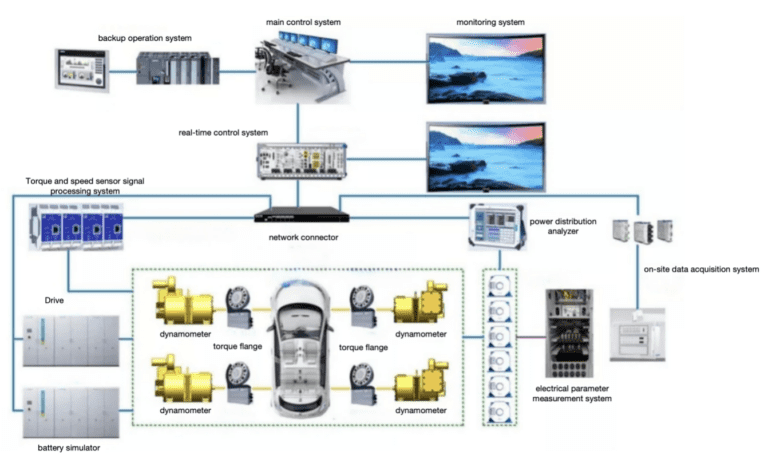
The shaft coupling dynamometer adopts a flexible design with a movable mode. The dynamometer and vehicle hub take a quick connection structure, therefore the user can quickly complete the connection between the vehicle and the dynamometer. The tray bracket of dynamometer support by universal wheels, which can move conveniently, at the same time it also simulate the actual steering function.
The flange shaft connect to the wheel hub of the vehicle adopts a hollow structure,in order to minimize the moment of inertia of the shaft system, improving the dynamic response capability of the dynamometer system. A transitional connection flange designs between the flange and the wheel hub of the vehicle, as the flange also adopts a weight reduction design to reduce the moment of inertia.
Axle-coupled dynamometer is a flexible test system with a very high degree of flexibility. Gli utenti possono combinare test a volontà, moreover can test four-wheel drive and two-wheel drive vehicles, separating electric drive powertrain tests. The shaft coupling dynamometer adopts a motor with extreme low inertia, moreover the real-time Ethernet communication control. Solution obtains a very high dynamic response speed, which complete the dynamic alternating working condition test of the load. Il sistema di dinamometro dell'accoppiamento dell'albero ha le seguenti funzioni:
1. Test di durata del veicolo, energy flow test, energy consumption test, acceleration test, road simulation test, braking performance test, fault detection, conformance test, braking energy recovery test
2. Test delle caratteristiche universali dell'intero veicolo
3. Driver nel test ad anello
4. Sviluppo e calibrazione della strategia di controllo dei veicoli
5. Test di efficienza del propulsore, speed and torque characteristic test, temperature rise test, controller control strategy development verification test, braking regenerative energy feedback test, external characteristic test, development matching optimization test, performance test and calibration test
6. Efficiency Map Test
7. Accelerated response test
8. Torque response test
9. Test di durabilità del carico ciclico allo stato stazionario
Base on the specific vehicle configuration, Condizioni di lavoro e modalità di lavoro, the energy generate and transfer/convert from the power source to the wheel end.
2) Efficienza/perdita di trasferimento di energia:
Nel percorso di trasmissione dell'energia, the lossy systems and components, with corresponding energy consumption form. La distribuzione quantificata del consumo di energia per i sistemi e i componenti del consumo di energia.

The key points of the vehicle energy flow test are the accuracy of the measurement, the synchronization of the measurement of different energy-consuming components, così come l'autenticità della simulazione delle condizioni del veicolo.
Al fine di migliorare l'accuratezza della misurazione dell'energia elettrica, È necessario configurare un analizzatore di potenza e un trasformatore ad alta precisione, use a power analyzer with a high-precision synchronous clock function, in order to synchronously collect and measure the signals of each sensor.
Test del flusso di energia del veicolo:
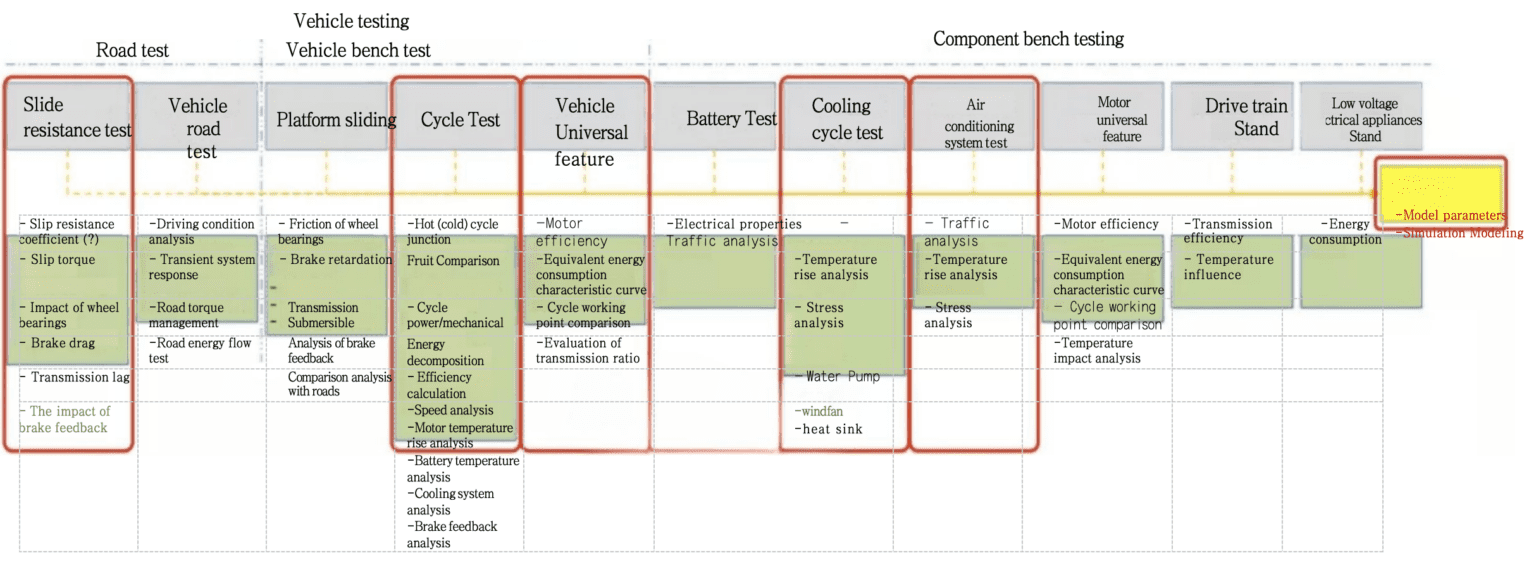
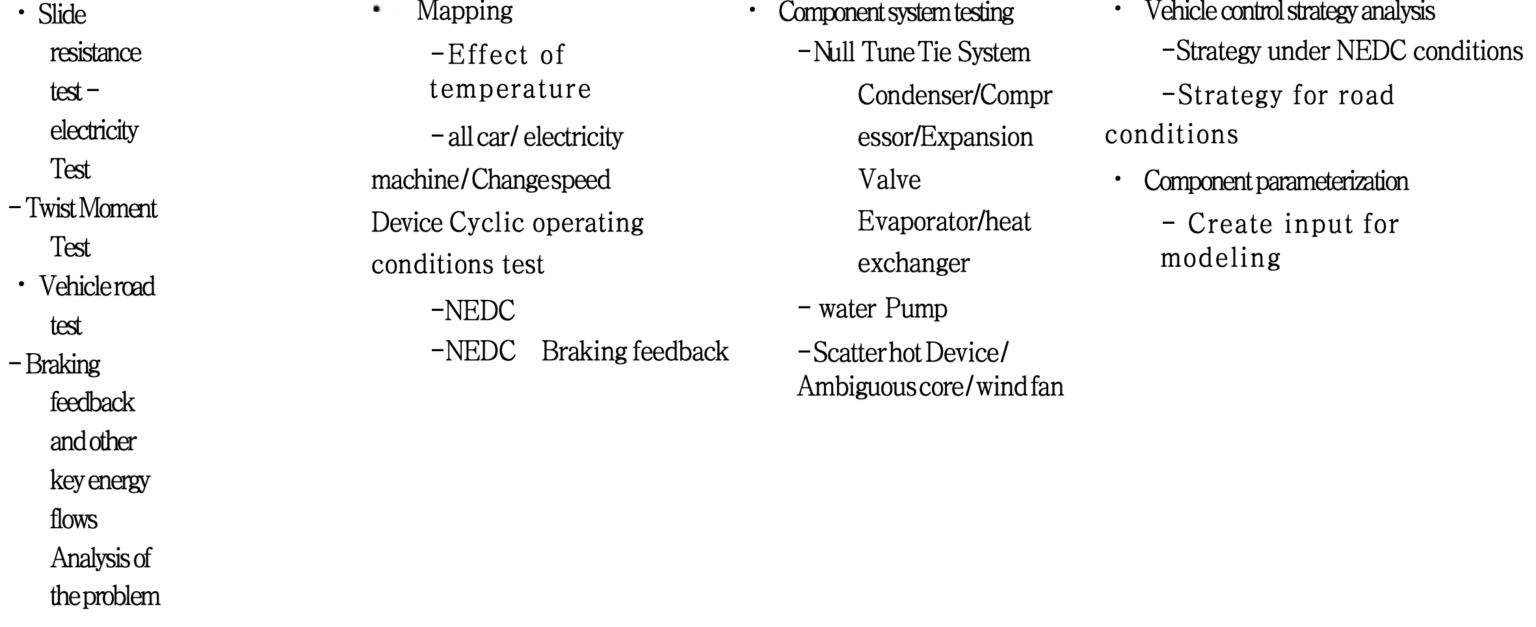
The software system mainly divide into the following parts:
★ Software di gestione dei test: Basic parameters and relevant control parameter settings require before operation, generare file di informazioni di test, and name by the test main control software.
Attraverso l'interazione con il computer di controllo in tempo reale durante il test, the process automatically manage and the specify via real-time information is process.
After the test finishing, Rapporti di prova, Recupero dei record di prova, Post-elaborazione dei dati, ecc. can provide to the users.
★ Software di controllo in tempo reale del banco di test: Through the acquisition of close-loop control sensor, and through interaction with the test management, computer obtains the upper-level solved control parameters. Providing the necessary lower-level calculations, real-time close-loop control of the speed, as well as torque of the driving and loading motors with other Real-time control of auxiliary facilities.
A unified human-computer interaction interface, which integrates the main information on the same machine; Display in tempo reale dei progressi del test, Dati di test principali, the status of the test piece, test bench and other information.
★ Test di acquisizione dei dati e software di post-elaborazione: Il sistema fornisce varie operazioni matematiche dei dati, including subtraction, moltiplicazione, divisione, integrazione, differenziazione, valore massimo, valore minimo, valore di picco, RMS, media, somma, ecc.
All software systems adopt modular design, con buona flessibilità e scalabilità. Main functional modules of the software are: Modulo quadro principale del programma, Modulo di controllo del sistema, Modulo di acquisizione dei dati, Modulo di registrazione dei dati, Modulo di analisi dei dati, Modulo di visualizzazione dei dati, Modulo di comunicazione, Modulo di riproduzione dei dati, Modulo di elaborazione di stampa, Modulo di calibrazione del sensore, Modulo di impostazione della funzione, AIUTO MODULO DI DOCUMENTO E MODULO DI POSTRATTURA DI POSTRATTURAZIONE DATI, ecc.
Dopo che il veicolo ha subito la calibrazione delle perdite e il test costiero, the formal test carry out. In questo momento, Il carico simulato del dinamometro è simile al carico stradale del veicolo.
Before the user starts for the device for testing, Il dispositivo ha bisogno di una calibrazione di attrito efficace (Il dispositivo verrà utilizzato solo se supera una certa velocità corrispondente alla calibrazione dell'attrito). In addition user can check the calibration status through the dial control page that displays the calibration status.
Gli utenti possono eseguire la calibrazione dell'attrito indipendentemente dal fatto che il veicolo sia attrezzato o meno, Ma il sistema non può distinguere tra perdita di attrito dell'attrezzatura e perdita del veicolo in questo momento. Therefore the user needs to make a new loss calibration for each new car. It recommends to do friction calibration where the vehicle is not equipped.
Allo stesso tempo, the user considers the friction loss will change with the adjustment of the ambient temperature. Perciò, it is necessary to warm up the device, before friction calibration or test and maintain its temperature until the end of the test.
When the vehicle loss calibration till end, La pagina aggiornerà e visualizzerà automaticamente la velocità di calibrazione massima. The calibration of friction loss can analogize to the calibration of vehicle loss. Maximum calibration speed show the lower of the friction calibration speed and the vehicle loss calibration speed.
5.4 Calibrazione di inerzia di base
The basic inertia calibration used to calibrate the basic inertia of the test bench, tra cui: the total moment of inertia of each transmission system, such as the drum, albero di trasmissione, e motore. La calibrazione di inerzia di base è una condizione necessaria per il corretto funzionamento del banco di prova.
Nel processo di rullaggio, the system first accelerates device to above the maximum speed required for taxiing, furthermore it enters the road simulation mode until the device is below the minimum speed required for taxiing. Additionally it passing the designated speed point, the moment Will be recorded. After system can accurately calculate the road simulation by calculating the time, moreover the average deceleration force for the specified taxi distance. Gli utenti possono trovare queste informazioni sulla pagina dei risultati del taxi.
The system can provide various dynamometer electromechanical inertia simulation, e simulare il carico della strada in base all'equazione:

Per qualsiasi domanda o supporto, si prega di contattare via e-mail all'indirizzo [email protected].
Puntiamo a rispondere tempestivamente.
Hai bisogno di assistenza immediata? Chiamaci al +86 156 1877 0706.
Il nostro team è pronto ad assisterti.
Ti invitiamo a visitare il nostro ufficio situato in 3F, Edificio 2, NO.511 Xiaowan Strada, Fengxian, Shangai, Cina.
Discutiamo di persona delle vostre esigenze.

© 2025 Shanghai EconoTechnology Co., Ltd. Tutti i diritti riservati.
Potenziare l'innovazione attraverso soluzioni di test affidabili.